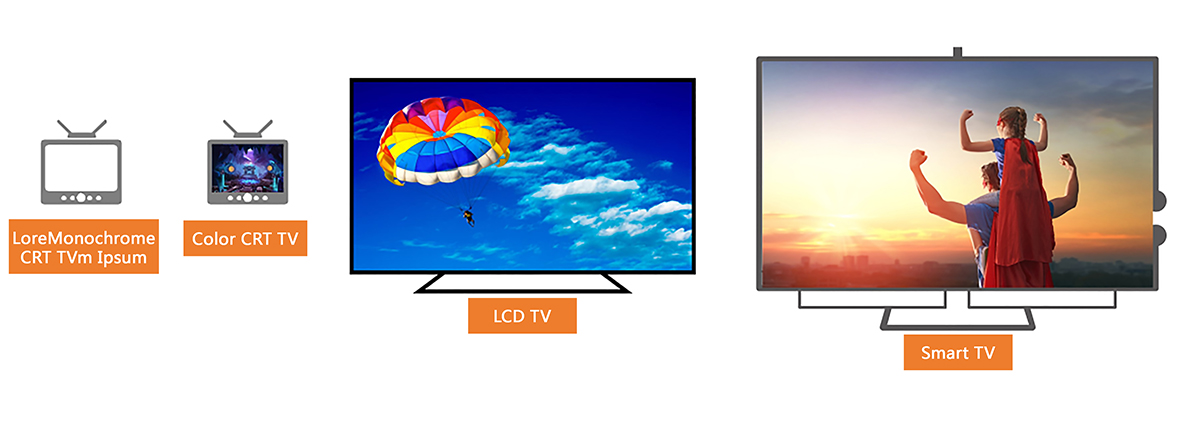Back
- Applications
- Products
- Support
- About HiSilicon
No Result
Optimal User Experience
Trailblazing TV technology has opened new doors
[ShangHai, China, July 24, 2020] In cathode ray tubes (CRT) era, TVs displayed images by emitting electron beams via electron guns. A longer CRT neck was required in order for the display to be enlarged. Therefore, the larger the screen on a TV, the larger the TV itself would need to be. Then in 1996, display technology underwent a significant paradigm shift, with the arrival of liquid crystal display (LCD) technology. The visual experience brought by LCD was clearer, more lifelike, and hence, more immersive. An LCD TV controls the liquid crystal molecules via electrodes to display images. As the screen enlarges, the TV does not need to enlarge accordingly; instead, the screen can be thinned, and even mounted on the wall to further save space. In addition, the resolution becomes higher and users are able to enjoy a more diverse range of content. In recent years, TVs have become intelligently digitized, and come to support such wide-ranging functions as gaming, video calling, and remote learning.

Simple but Refined
A premium chipset for non-smart ATVs
Nonetheless, a lot of the TVs in circulation have yet to be digitized, while not all households can afford smart TVs. About 30% of TVs produced every year are non-smart TVs, which tend to feature lower performance, with screens of less than 40 inches and resolution at under 1080p.
HiSilicon's latest premium smart media chipset is tailored to this still massive non-smart ATV market. The chipset is capable of receiving analog signals, and supporting external inputs such as HDMI, VGA, and CVBS, as well as USB playback. With this high-quality solution, HiSilicon solves the complex issues for industry partners.
.png)
The high-performance 28 nm chipset integrates a HiSilicon-developed CPU, a timing controller (TCON) for the screen that improves the image quality to a significant degree, and cutting-edge, proprietary Super Wide Sound (SWS) technology. It is also capable of running HUAWEI LiteOS, which dramatically streamlines the development process.
It's natural to wonder if a 28 nm chipset is sufficient for use in a device, given that smartphone SoCs now use the 5 nm process. However, it's important to note that the chipset is used in products with simpler functions and higher price sensitivity than smartphones, and thus there is little need to use a more advanced process, as evidence by the fact that the mainstream process used in chipsets of this type is 40 nm, more than enough to meet the everyday needs of users. The highly-integrated 28 nm chipset offers users a wide range of benefits, including the following:
• Outperforms similar products by 20%, while guaranteeing excellent heat dissipation.
• Integrates a TCON, which enables the SoC to work directly with the screen, minimizing the costs of the entire
system.
• Adaptable to all FHD/HD screens on the market, reducing the development and adaptation work required for TV
vendors.
In addition, the chipset works with the HUAWEI LiteOS, which features a super small kernel (< 100 KB) and uses a minimal amount of memory. The real-time OS facilitates multi-process synchronous processing, supporting dynamic and distributed loading, and the faster running provides developers with a superior operating experience. For places that are prone to power failures, where circuits tend to be unstable, HUAWEI LiteOS's quicker startup works to ensure that developers can still enjoy enhanced operations.
The high-quality chipset also provides SWS sound effects free-of-charge. The overall performance offered by SWS is comparable to that for mainstream surround sound effects. With enhanced audio and imaging quality, the products that use the chipset are able to provide users with next-level audiovisual immersion.

Technology has made life more enriching in a myriad of different ways, and the extension of premium audiovisuals at affordable price to analog TVs, represents the latest demonstration of this principle. HiSilicon will continue to enhance its non-smart TV chipsets, and launch dedicated chipsets for digital TVs, with the goal of making the best possible products ever accessible to users in cooperation with industry partners.
This site uses cookies. By continuing to browse the site you are agreeing to our use of cookies. Read our privacy policy